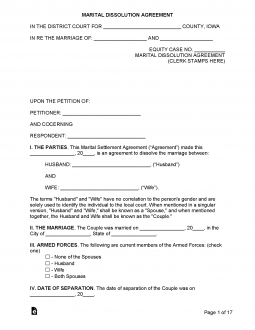Updated September 01, 2023
An Iowa marital settlement agreement is a legally binding contract between a married couple that defines the terms of their divorce. The document sets out the conditions of the marriage’s dissolution, including spousal support, division of property, distribution of finances, investments, liabilities, and child custody. The couple must execute the agreement before or during divorce court proceedings to have the document incorporated into the court’s judgment. It is generally recommended that couples consult with legal professionals when drafting a marital settlement agreement to ensure that the arrangement is thorough and fair.
Table of Contents |
Divorce Laws
Statutes – Iowa Code Title 15, Chapter 598 (Dissolution of Marriage and Domestic Relations)
Alimony (§ 598.21A)

In considering the allocation of alimony (legally known as “spousal support”), the court will take into account the length of the marriage, distribution of property, and the provisions of an antenuptial agreement (if one exists). Furthermore, they will consider the age, health, educational level, and earning capacity of each party.
- Alimony Calculator – calculators.law
Child Support (§ 598.21AB)
Under state law, each case will be judged on its individual facts in the most “just and appropriate” manner and in accordance with the Iowa Child Support Guidelines.
- Child Support Calculator – divorcehq.com or alllaw.com
Division of Property (§ 598.21(5))

All property will be fairly divided in consideration of multiple factors including the contribution, earning capacity, child custody, and economic circumstances of each party. This type of property division is often referred to as “equitable distribution.”
Grounds for Divorce (§ 598.5(g))
Iowa is a no-fault divorce state, which means that neither party has to be accused of wrongdoing in order to apply for a divorce. The only requirement is that a breakdown of the marriage relationship must be declared.
Interim Support (§ 598.10)
The court may order one party to pay a sum of money to the clerk to be distributed to the other party as financial support during the divorce process.
Residency (§ 598.5(k) and § 598.9)

To file for divorce, petitioners must be Iowa residents for at least one (1) year (any time spent out of state must be deducted from the total) and offer proof of residency. If the petitioner’s residence is not adequately proved, their case will be dismissed by the court.
Divorce Forms
- Where to File – District Court in County of Residence
- Filing Fee – $185 (§ 602.8105(1)(a))
- How Long Does it Take? At least ninety (90) days
Uncontested Divorce with No Children:
- Guide to Representing Yourself in an Iowa Divorce Case with no Minor or Dependent Adult Children
- Form 101 – Petition for Dissolution of Marriage With No Minor or Dependent Adult Children
- Form 104 – Original Notice for Personal Service
- Form 105 – Acceptance of Service
- Form 106 – Directions for Service of Original Notice
- Form 109 – Application and Affidavit to Defer Payment of Costs
- Form 110 – Affidavit of Service of Original Notice and Petition for Dissolution of Marriage
- Form 111 – Protected Information Disclosure
- Form 115 – Answer to Petition for Dissolution of Marriage With No Minor Children
- Form 122 – Motion
- Form 124 – Financial Affidavit for Dissolution of Marriage With No Minor Children
- Form 125 – Affidavit of Mailing Notice
- Form 127 – Request for Relief in a Dissolution of Marriage With No Minor Children
- Form 128 – Settlement Agreement for a Dissolution of Marriage With No Minor Children
Uncontested Divorce With Children:
- Guide to Representing Yourself in an Iowa Divorce Case with Children
- Form 201 – Petition for Dissolution of Marriage with Children
- Form 202 – Petition Cover Sheet for a Dissolution of Marriage with Children
- Form 203 – Confidential Information Form
- Form 204 – Original Notice for Personal Service
- Form 204a – Original Notice for Personal Service (paper)
- Form 205 – Acceptance of Service
- Form 206 – Directions for Service of Original Notice
- Form 209 – Application and Affidavit to Defer Payment of Cost
- Form 210 – Affidavit of Service of Original Notice and Petition for Dissolution of Marriage
- Form 211 – Protected Information Disclosure
- Form 212 – Joint Written Statement About Paternity
- Form 213 – Motion to Disestablish Paternity
- Form 215 – Answer to Petition for Dissolution of Marriage with Children
- Form 221 – Affidavit for Temporary Custody and Visitation
- Form 222 – Motion in a Dissolution of Marriage with Children
- Form 224 – Financial Affidavit for a Dissolution of Marriage with Children
- Form 225 – Affidavit of Mailing Notice
- Form 227 – Request for Relief in a Dissolution of Marriage with Children
- Form 228 – Settlement Agreement for a Dissolution of Marriage with Children
- Form 229 – Agreed Parenting Plan
- Form 230 – Proposed Parenting Plan
How to File for Divorce in Iowa (6 steps)
- Fill Out Divorce Forms
- File Petition
- Serve Respondent
- Respondent’s Answer
- Marital Settlement Agreement and Agreed Parenting Plan
- Decree of Dissolution of Marriage
1. Fill Out Divorce Forms
To become legally divorced, married couples must have a judge approve the terms of their “dissolution of marriage” (the legal term for divorce). If the county in which the case will be filed accepts electronic filing, the divorce forms must be filed online unless the court gives a formal exemption. Individuals should contact their local district court to verify whether electronic filing is provided. To file divorce forms electronically, spouses will be required to register an account with the Electronic Document Management System (EDMS) (see EDMS guide).
The following forms must be completed by the “petitioner” (the spouse who is opening the divorce case) to file a Petition for Dissolution of Marriage:
- Petition for Dissolution of Marriage (without children / with children)
- Original Notice for Personal Service (without children / with children) – for electronic filing only.
- Protected Information Disclosure (without children / with children)
Additional forms required for paper filing only:
- Petition Cover Sheet for a Dissolution of Marriage (with children)
- Confidential Information Form (with children)
- Original Notice for Personal Service (with children)
Consult the ‘Guide to Representing Yourself in an Iowa Divorce Case’ (without children / with children) for more information.
2. File Petition
If the petitioner is filing their petition by paper through their district court, they will need to send additional copies of each form to their spouse (who is referred to as the “respondent”) with the exception of the Confidential Information Form. Petitioners are required to pay a filing fee to the clerk of court, or file an Application and Affidavit to Defer Payment of Costs (without children / with children) to apply to have fees waived. The basic fee for filing a petition is one-hundred eighty-five dollars ($185); however additional filing fees may be required depending on the county. If the petitioner is filing online, they will receive a Notice of Electronic Filing (NEF) when their petition has been approved by the clerk of court. Once their filing has been approved, the petitioner can download and print copies of the petition, Original Notice for Personal Service, and Protected Information Disclosure to serve on the respondent.
3. Serve Respondent
The petitioner will have ninety (90) days from the date that they file their petition to serve copies of the divorce papers on the respondent. The case will be dismissed if the documents are not served in time. The respondent can be served the documents by mail or in-person by the petitioner, county sheriff, civil process server, or a third party. After being served, the respondent must fill out an Acceptance of Service (with no children / with children) to be filed with the clerk of court after execution. If a third party (other than the sheriff or a civil process server) serves the forms, they must fill out an Affidavit of Service (without children / with children) that must also be filed with the court. If a sheriff serves the divorce papers, the petitioner must fill out and file the Directions for Service of Original Notice form (without children / with children).
4. Respondent’s Answer
Within twenty (20) days of being served divorce papers, the respondent must complete an Answer to Petition for Dissolution of Marriage (without children / with children) and file it with the court clerk. If there is protected information included in the Answer, the respondent must also fill out and file a Protected Information Disclosure (without children / with children). In the event that an Answer is not filed within the time limit, the court may enter a judgment against the respondent.
5. Marital Settlement Agreement and Agreed Parenting Plan
In an uncontested divorce, both spouses agree on the terms and conditions of their marriage’s dissolution. This arrangement must be formalized in a Settlement Agreement for a Dissolution of Marriage (with children / without children) drafted with or without legal consultation. Both parties are also required to file Financial Affidavits (without children / with children) declaring their financial situation. If the couple has children, they must also complete the Agreed Parenting Plan document. The petitioner can also file a Motion in a Dissolution of Marriage (without children / with children) to request a shortened waiting period for receiving a judgment. These forms must be filed with the court clerk prior to the final hearing.
6. Decree of Dissolution of Marriage
After all divorce forms have been filed and served as required, the petitioner will need to arrange a meeting with the judge through the court clerk. At the meeting, the petitioner should bring their copies of all relevant documents for reference. The judge will review the case and, if everything is in order, issue a Decree of Dissolution of Marriage. The decree will be delivered to the petitioner by mail or in-person by the clerk. If the petition was filed electronically, the petitioner will receive a notification when their decree is available for download. Once the decree has been issued, the divorce and all its terms will be final. If either party included a name change to restore their previous name in their divorce papers, they can update their ID by presenting a copy of their divorce decree to the necessary entities. If the name restoration wasn’t included in the petition, or if the individual wishes to adopt a new name, they will need to file a Petition for Name Change with their District Court.


